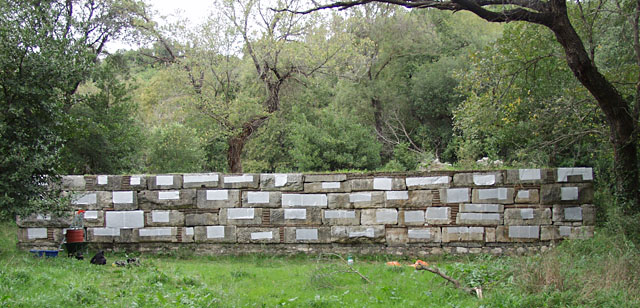
The Inscription Wall at ButrintDuring September-October 2002 a programme of conservation and recording of the inscriptions in the theatre and in the so-called "Inscription Wall" at Butrint was undertaken by a small team consisting of P.M. Pearce (British Museum: conservator), C.V. Crowther (CSAD: epigraphist), S. Martin (Institute of World Archaeology) and S. Golemi (University of Gjirokastra), with funding from the J.F. Costopoulos Foundation. The aims of the programme were to assess the condition of the inscriptions; to make paper squeezes and take photographs of the inscriptions before further deterioration ensued; to identify and record the individual inscriptions to support future study of them, pending the publication of P. Cabanes and F. Drini's Corpus of inscriptions of Bouthrotos (Inscriptions de Bouthrôtos - IB). P.M. Pearce carried out a full conservation assessment: individual blocks were cleaned, photographed and recorded, and minor consolidation undertaken where appropriate. Her judgment that the surface condition of the inscriptions would support the taking of squeezes allowed the second stage of the programme to be undertaken. C. Crowther, assisted by S. Martin and S. Golemi, made paper squeezes of 99 identifiable and accessible inscriptions in the Inscription Wall and 14 inscriptions in the diazoma of the theatre. Two squeezes of each inscription were taken. One set of squeezes was left in Butrint for transmission to Tirana; the other set was taken to the Centre for the Study of Ancient Documents in Oxford. In Oxford further work was undertaken to catalogue, identify and digitise the squeezes by C. Crowther and a graduate assistant, S. Rishoj-Christensen, with further help from S. Golemi. Cataloguing and digitisation of the squeezes were completed during the academic year 2003/4 while S. Golemi was in Oxford as a visiting graduate student. 
Squeezes drying on the inscription wall at Butrint Printed copies of a catalogue of the inscribed blocks have been deposited at the Butrint Foundation and the Institute for World Archaeology, together with copies of a cd-rom containing scanned images of the paper squeezes and electronic copies of the catalogue. Although some of the blocks in the Inscription Wall appear to have suffered surface damage during its construction and the current disposition of the blocks has exposed all of them to additional and progressive surface erosion and moss and lichen growth, collation of the identifiable texts against the draft IB Corpus shows that the majority remain for the moment legible. In this respect, the conservation and recording programme seems to have been timely. With the exception of a dedication to Asklepios and Hygieia, the inscriptions registered in September-October 2002 are all records of manumissions - the freeing of slaves by their owners through a procedure that entrusted them to the custody of one of the city's gods. It is this group of texts, making up two-thirds of the Greek inscriptions found at Bouthrotos and dating for the most part to the second and early first centuries BC, that gives the city's epigraphy its particular character and importance. The inscriptions record large numbers of names: of slaves, of magistrates, and of slave-owners and their immediate families and associates. Many of these names are rare and specific to Bouthrotos and its surrounding region. The conditions in which the inscriptions are currently preserved and have in the past been recorded have not always favoured accurate registration of this important onomastic information. The paper squeezes made in October 2002, which are available for study in Tirana and Oxford and potentially more widely accessible in their digitised form, will provide an invaluable resource for the continuing study of this material. Home | What's New | Events | Images | Links |
| Created on |